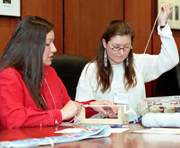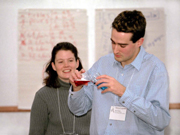
Trina Slapcoff,
a Concordia student, and Cathy Sewell, from the University of Alberta,
in a workshop on using beadwork to teach mathematics.

Virginia Hall
and Geoff Black, who are both from Actua, the umbrella association for
summer science camps, take part in a workshop on using water in the
science curriculum.
Photos by Andrew
Dobrowolskyj
|
by Eilis Quinn
It is time to challenge the idea of math and science as sets of abstract
laws and principles and start approaching them as skills we use naturally
in our day-to-day lives.
This was the message that rang out in many of the workshops offered to
math and science teachers of aboriginal students at the DreamCatching
2001 conference which took place February 7 to 10 in the Henry F. Hall
Building.
Workshops covered areas such as the integration of information technologies
into science lessons, instruction tools to help teach hands-on science
in the classroom, and career planning for aboriginal students. But workshops
also touched upon the education of younger children and the well-being
of teachers, as part of a total approach to education.
At a workshop titled “For the Seventh Generation: Connecting Mathematics
and Aboriginal Culture in the Classroom,” the possibilities for developing
an understanding of mathematical concepts through aboriginal beadwork
and patchwork were explored.
Dr. Jim Barta, from the Department of Elementary Education at Utah State
University, described his approach as ethnomathematics: the relationship
of math to culture. In the workshop, Barta promoted the idea that all
mathematical concepts appropriate to elementary students can be illustrated
with beadwork.
“The way we teach math and science often causes many obstacles,”
Barta said. “In the way we teach native kids, we turn them away from
who they are. What we should be saying is, ‘You’re a gifted
beadworker and that already makes you a gifted mathematician.’”
Half-way through the workshop, participants Allan Bork, a teacher at Sherbrooke
School in Edmonton, and Darren Googoo, Education Director in Membertou,
N.S., were already planning how they were going to implement the workshop’s
ideas into their lesson plans.
Bork, who teaches at a school that is 95-per-cent aboriginal, even hoped
to include beadwork in the final exam.
“Look at this!” Bork said, holding up the multicoloured beadwork.
“You’ve got everything here, percentage, ratio, graphing —
even algebraic geometry!”
Googoo, intrigued by the whole subject of ethnomathematics, saw an opportunity
to adapt some of the traditional Mi’kmaw dice games of his region
to the curriculum.
“We haven’t allowed our children to see enough of their culture
in the classroom,” he said. “Culture isn’t static. They
need to be able to see it, change it and make it their own. That’s
what this can do for them, along with getting them hooked on mathematics
when they are young.”
In a workshop titled “WECHE Teachings for Challenging Expectations,”
Elmer Ghostkeeper stressed the balance of physical, mental, emotional
and spiritual elements of teaching.
“Students can see whether you love what you are doing or not,”
Ghostkeeper told the teachers. “If students see that you are balanced
and committed, they will give that back to you in the classroom.”
Ghostkeeper asked teachers to come away from the workshop challenging
the Western approach to science as theoretical and fragmented and to look
at science as it is in native culture: a series of relationships and cycles,
part of everyday life.
By the end of the conference, teachers enthusiastically described how
workshops had inspired a wealth of new ideas to take back to their communities.
Barbara Muller, a teacher of secondary level math and science at Ullurniaq
School in Kangiqsualujjuaq, Northern Quebec, echoed the sentiments of
many DreamCatching 2001 participants. She said, “The holistic approach
[to education] has given me a lot to think about.”
The conference was sponsored by Concordia’s Native Access to Engineering
Program (NAEP), which is in turn sponsored by several departments of the
federal government. The event started with the official launch of Distributed
E-Learning for First Nations Science Education (profiled in the last issue
of CTR, February 8).
|
|
|



